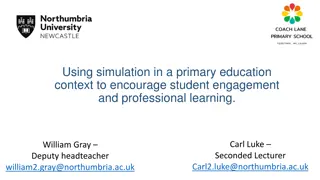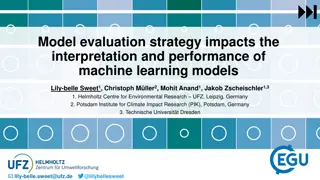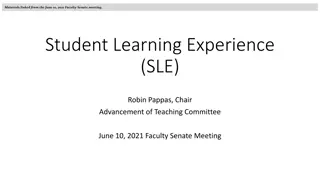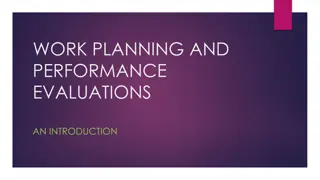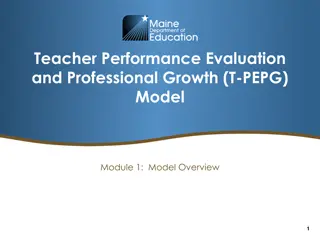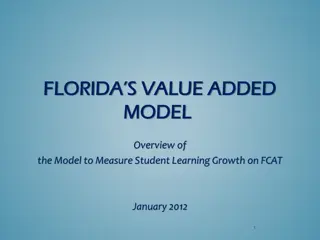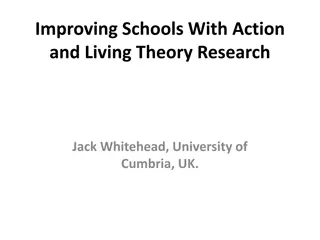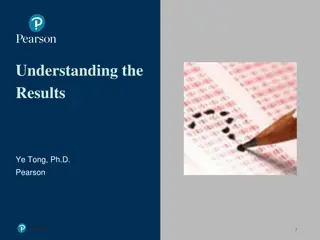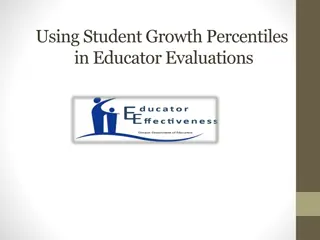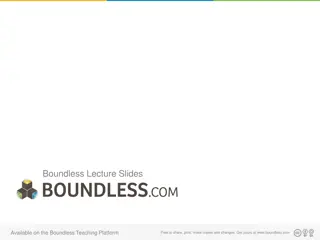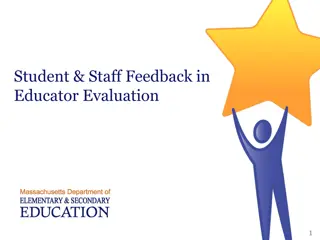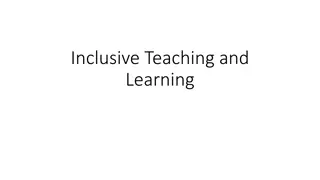Understanding Student Learning and Growth in Performance Evaluation for Special Educators
Exploring the significance of student learning and growth as a measure of effectiveness in the Performance Evaluation and Professional Growth system for special educators. Key considerations, requirements, and strategies are discussed to enhance professional growth. Access resources and gain insights to improve educational outcomes.
- Student Learning
- Growth Measurement
- Special Education
- Professional Development
- Performance Evaluation
Download Presentation

Please find below an Image/Link to download the presentation.
The content on the website is provided AS IS for your information and personal use only. It may not be sold, licensed, or shared on other websites without obtaining consent from the author. Download presentation by click this link. If you encounter any issues during the download, it is possible that the publisher has removed the file from their server.
E N D
Presentation Transcript
Student Learning and Growth as a Measure of Effectiveness in a Performance Evaluation and Professional Growth (PEPG) System: Considerations for the Special Educator HOME HOME
Outcomes for Participants Gain access to current Educator Effectiveness statute and rule Review existing and future resources Understand the Performance Evaluation and Professional Growth (PEPG) requirements for Student Learning and Growth (SLG) as a measure of effectiveness Understand the meaning of "growth measure" Identify the local decisions that influence the Student Learning and Growth factor and rating Understand the use of the term SLO (Student Learning Objective) Understand the differences between IEPs and student growth targets in a PEPG system Identify key considerations for special educators related to Student Learning and Growth (SLG) measures Consider some strategies to mitigate challenges Provide input on considerations and strategies General Q and A HOME HOME
To Access Current PEPG Statute and Rule Statute: Maine Revised Statute Title 20-A, Educator Effectiveness, Chapter 508 http://www.mainelegislature.org/legis/statutes/20-A/title20-Ach508.pdf Governing Rule: Rule Chapter 180 http://maine.gov/doe/rule/changes/chapter180final%202014.doc HOME HOME
Helpful Links Maine Department of Education Website http://www.maine.gov/doe/ Educator Effectiveness Website http://www.maine.gov/doe/effectiveness/index.html Extensive List of assessments compiled by Massachusetts (Many can measure growth) HOME HOME
Student Learning and Growth as a Measure of Educator Effectiveness HOME HOME
Required: Multiple Measures of Educator Effectiveness Student Learning and Growth Professional Practice Multiple Measures HOME HOME
Defining 'Student Learning and Growth' As a factor in the summative effectiveness rating of a teacher or principal, 'Student Learning and Growth' is based on data that measures a change in an *instructional cohort's academic knowledge and skills between two points of time. *The student or group of students whose academic growth will be attributed to a Teacher. HOME HOME
Learning and Growth Measure: The Basics Based on Content Standards * Attributed to individual or multiple teachers of record *May be applied outside TOR under certain conditions Growth Measure Requires Pre and post assessment Based on an assessment that meets criteria for "permissible measures" in Rule Chapter 180 HOME HOME
Local Decisions that Influence the Student Learning and Growth Factor and Rating The method of combining SLG and other measures of effectiveness (e.g. weights or thresholds applied to measures) The method of scoring SLG measures to determine teacher rating Procedures for setting growth targets Requirements for attribution to teachers (Teacher(s) of Record; collective attribution) Criteria for size of instructional cohort Criteria for length of instructional interval of time Requirements for number of growth targets per year/summative rating Local requirements for use and development of assessments Method of recording and monitoring elements of the growth target, e.g, the Student Learning Objective (SLO) HOME HOME
What Is An 'SLO'? HOME HOME
Clarifying'SLO' The term 'SLO' is frequently used interchangeably with 'student growth target' or 'measure, ' which can cause some confusion when people look for guidance on approaches to the student growth measure (e.g., the quotation on slide 17). While the guidance may be sound, it's application may be unclear if readers do not understand the common usage of the term. The table on the following slide provides a primer on the SLO for consideration of the SLO both as a term that needs to be defined and as a useful tool that districts may adopt. Participants are encouraged to refer to the Maine DOE Student Learning Objective (SLO) Framework Handbook for Teachers and Administrators for more information on the SLO. HOME HOME
What is an SLO? Is Is not A process-framework for developing, articulating, and recording A document Modifiable Simply an acronym A measure of student growth A leveler Standardized The SLO Does Does not.. Inherently constitute a growth target Assess students Satisfy a state requirement for student learning and growth measures Inherently provide quality assurances Have a placeholder for student growth targets Guide decisions about aligning content, instruction, and assessment Record important information Provide a locus of conversation HOME HOME
The Application of the SLO in a PEPG System Professional Evaluation (PE) Records the growth target Professional Growth (PG) Reported by teachers to be the "most valuable part of the PEPG system" for improving practice Relies on and promotes important collegial conversations about learning and teaching Fosters improvement of practice with each SLO Universal process allows for access to supportive resources Based on researched methods of improving student progress Holds a record of an instructional cohort of students and monitors changes to the instructional cohort Identifies the teacher(s) of record Teacher-directed and monitored; reduced risk of inaccurate data Allows for flexibility in a student- centered system HOME HOME
Student Learning and Growth (SLG) Target Contrasted with Individual Education Plan (IEP) HOME HOME
Student Learning and Growth (SLG) Target Statute: Title 20-A MRSA Chapter 508 Chapter 180: PERFORMANCE EVALUATION AND PROFESSIONAL GROWTH SYSTEMS Criteria intended to ensure accurate attribution of student growth to the teacher responsible for instruction. Individualized Education Plan (IEP) Statute: Title 20-A MRSA Chapters 301, and 303 Chapter 101: MAINE UNIFIED SPECIAL EDUCATION REGULATION Criteria intended to ensure that "Highly Qualified" teachers deliver direct instruction. Governing Statute and Rule Chapter Teacher of Record Criteria Two teacher-based criteria in Rule: "The teacher of record, who is also the highly qualified teacher in a specific content area, provides the student grade for specialized instruction." Multiple criteria in Rule, many of which are based on student enrollment, attendance, and presence for pre and post assessments. HOME HOME
Student Learning and Growth (SLG) "To improve educator effectiveness by clearly setting forth expectations for student learning and growth, and providing actionable feedback and support to help educators meet those expectations" (Rule Chapter 180). Individualized Education Plan (IEP) To ensure that all children with disabilities have available to them a free appropriate public education that emphasizes special education and related services designed to meet their unique needs and prepare them for further education, employment and independent living" (IDEA). To track and report individual student progress toward attaining goals Purpose To measure the impact of a teacher or teachers on student progress toward proficiency Use of Data HOME HOME
Student Learning and Growth Target (SLG) Applies to a group of students Individualized Education Plan (IEP) Highly individualized Application to Students May include multiple goals, including non-academic goals Usually a single growth target, must target academic knowledge and skills Teacher-developed with administrative oversight Teacher-based: applies to a single course or learning experience assigned to a teacher or teachers Focus of Goal Multiple parties involved in development Student-based; may apply in multiple courses or contexts Development Process Instructional Context HOME HOME
The (In)Advisability of using an IEP Goal as a Measure of Teacher Effectiveness Center on Great Teachers and Leaders Policy Brief (March 2013) "The Council for Exceptional Children explicitly recommends that IEP goals not be used as SLO growth targets. An SLO is intended as a long-term academic goal for groups of students. An IEP is a goal set for an individual student and is highly specific to that individual student. Using IEPs in an SLO process undermines the integrity of both processes (Council for Exceptional Children, 2012)." HOME HOME
Special Considerations for Special Educators HOME HOME
Special Considerationsfor Special Educators 1 Consideration Diversity of instructional contexts: Challenge Possible Approach Understand the possibilities for attributing SLG to teachers: No single approach to teacher of record applies to all contexts. Resource Room Co-Teacher Multi-grades Multi-Contents Push-in/Pull-out Functional Life Skills Individual attribution Multiple Teachers of Record (Co-teaching) *Collective attribution For Functional Life Skills, growth targets can be based on developmental needs HOME HOME
Teacher of Record: Definitions "Teacher means a person who provides classroom instruction to students in a general education, special education or career and technical education program. It does not include adult education instructors or persons defined as educational specialists in State Board of Education Rule Chapter 115, section 2.20 [athletic director, school counselor, library-media specialist, literacy specialist, school psychologist, school nurse, special education consultant, speech-language clinician, or career and technical education evaluator.] The Teacher of Record is the teacher to whom the academic growth of a student in a course or other learning experience is attributed, in whole or in part. HOME HOME
Teacher of Record: Criteria A teacher is a teacher of record for a student only if: (1) The student is enrolled in the course or other learning experience taught by that teacher; (2) The student was present and was subject to instruction by that teacher at least 80% of the scheduled instructional time for that course or learning experience [associated with the learning and growth targets] with that teacher; and (3) The student took both the pre-test and the post-test designed to measure achievement in that course or learning experience. HOME HOME
Attribution of Student Growth Measures to More Than One Teacher A student s academic performance may be attributed to more than one teacher if 1) The criteria for teacher of record are met for each teacher OR 2) The criteria for collective measures are met HOME HOME
Collective Measures For comparison with multiple teachers of record; not a solution for the challenges faced by Sp. Ed. Teachers Rule Chapter 180 states, "A PEPG system may include academic growth of students outside the teacher s instructional cohort. [For example, a school may wish to apply measures of student growth in reading on a state assessment to all teachers in the school.] Any such use of a collective measure must: A. Be agreed to by teachers to whom it will be applied; an SAU must submit to the Maine DOE in its approval application the process by which agreement is obtained. B. Comprise not more than one-fourth of the total student growth measure for an individual teacher." HOME HOME
Special Considerations for Special Educators 2 Consideration Small instructional cohort in self-contained setting Challenge Possible Approach Understand the various approaches to setting growth targets (Maine DOE SLO Handbook). Approaches to setting growth targets taken by general educators may not be appropriate for small groups. Set class-/group-wide, differentiated growth targets (example next slide). HOME HOME
Example of Differentiated Growth Target Half (or ) the Gap OR *Maximum score minus base score /X = Growth Target (*Thanks to RSU 74 for this equation) Students grow half (or some percentage) of the performance gap to the maximum. In this example each student is expected to achieve half the points between his or her initial score and the maximum score. Target equation is the same for all, but the targets are based on individual baseline scores. Student A: Student Baseline Target 100-10 = 90 (gap) 2 = 45 (half the gap) A 10 of 100 55 of 100 Student A B C 50 of 100 Baseline 10 of 100 75 of 100 50 of 100 Target 55 of 100 88 of 100 75 of 100 75 of 100 B 75 of 100 88 of 100 10 (base) + 45 (1/2 gap) = 55 (target) C HOME HOME
Special Considerations for Special Educators 3 Consideration Small instructional cohorts in self-contained settings (cont.) Challenge Possible Approach Districts could establish a minimum number of students (district-wide); special educators could then "stack" cohorts to reach the minimum. Evaluators need sufficient data to measure a teacher's impact on student growth. OR Districts may wish to base the special educator's rating on the assigned cohort, even if it is small. HOME HOME
Special Considerations for Special Educators 4 Consideration Transient populations combined with small class sizes Challenge Possible Approach Defer teacher's summative rating until enough data is generated. Surviving instructional cohort could be too small. Allow for staggered or prorated student SLG targets for students who arrive after the pre-assessment. i.e., Students who took the pre- assessment may not be present to take the post- assessment OR Students may be added to the class after the pre-assessment has been administered and the growth targets set. These students would still need to take an appropriate y modified pre-assessment. Eighty-percent rule would apply to modified interval of instruction. (Illustration on next slide) HOME HOME
Illustration: Changes to Instructional Cohort Beginning Cohort...........................Mid-Year Surviving Cohort Took Pre- assessment Sufficient data to rate teacher's impact on student growth? Left the class Joined class mid-year; modified pre- assessment and growth target Joined class too late in year to be included in data
Special Considerations for Special Educators 5 Consideration Students are pushed in or pulled out Challenge Possible Approach Special Educator works closely with general educator to coordinate the push-ins or pull- outs to: The instructional time related to a SLG target set by either the special educator or the general educator could be impacted by the absence of a student. Avoid impacting the instructional time related to the SLG target OR Support a collaboratively developed SLG target that will be attributed to both teachers. Absences have implications for satisfying Teacher of Record criteria for attendance. HOME HOME
Other Considerations or Challenges? HOME HOME
Recommendations Be involved in the development of the system to ensure that implications to special education are considered. Look to the Student Learning Objective Handbook for guidance. Look to other states for guidance. Communicate with the Department when questions or unresolved problems arise . Keep the ultimate goal in mind: using student data to inform and improve instruction so that all students are successful. HOME HOME


